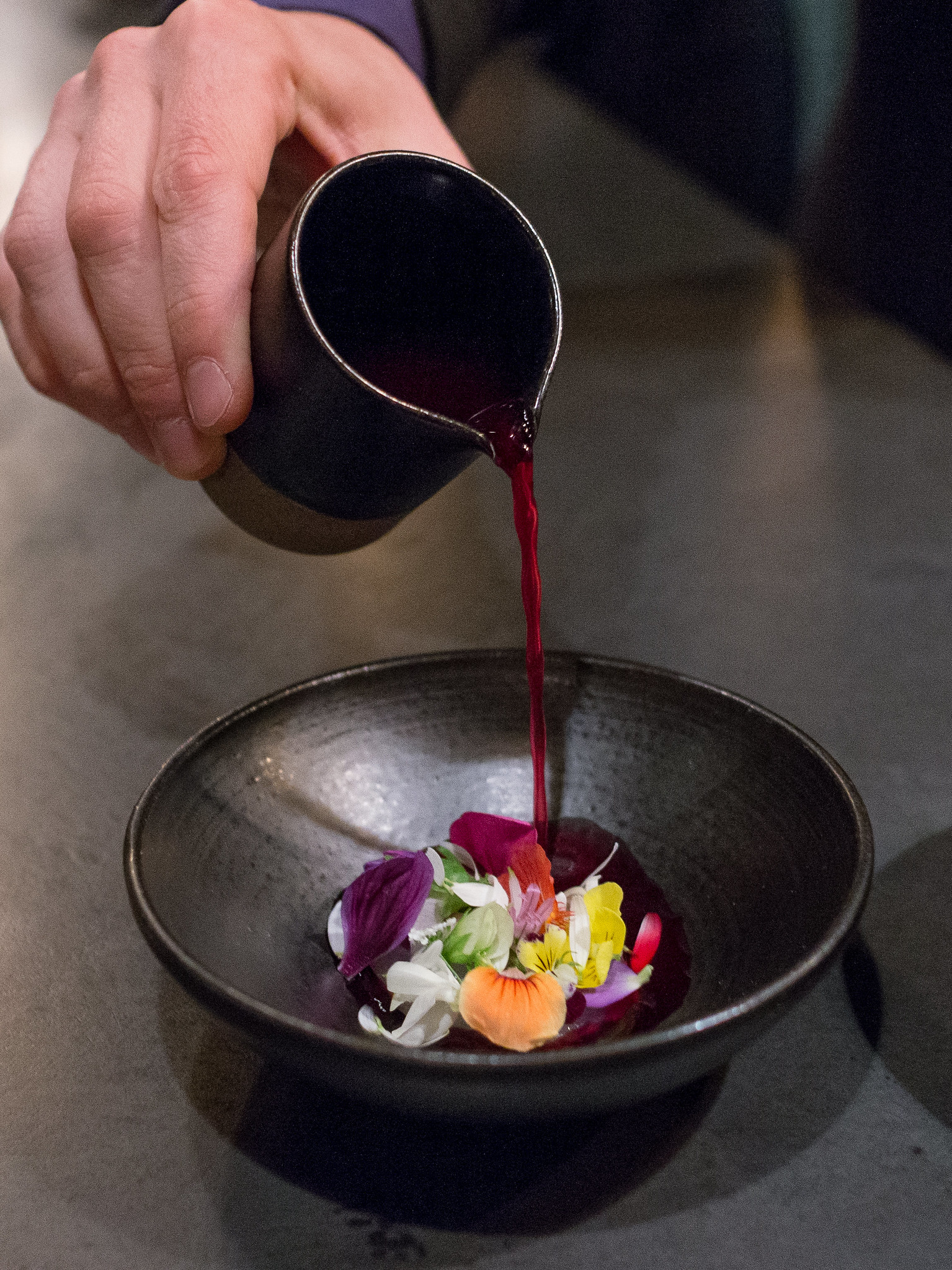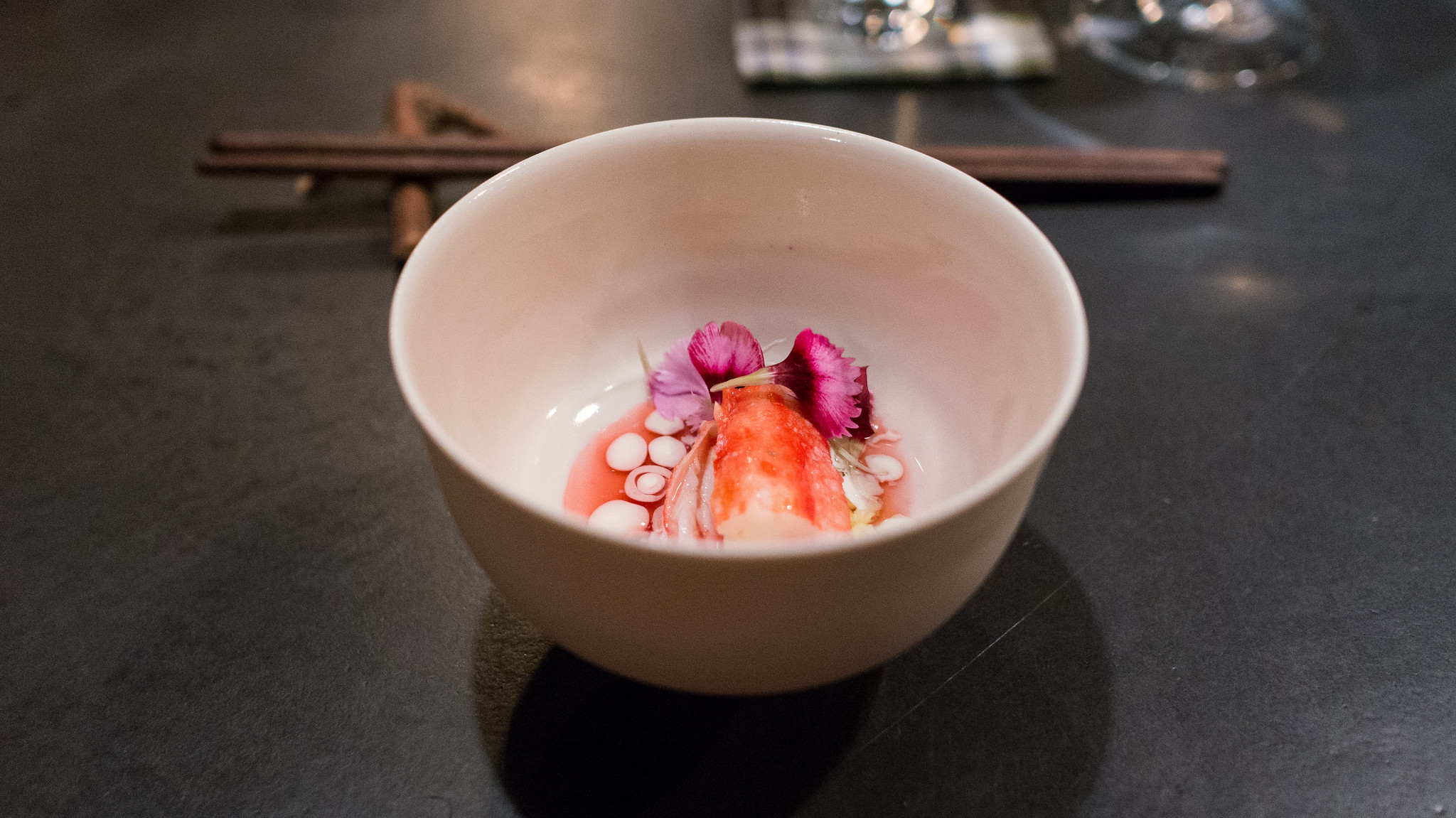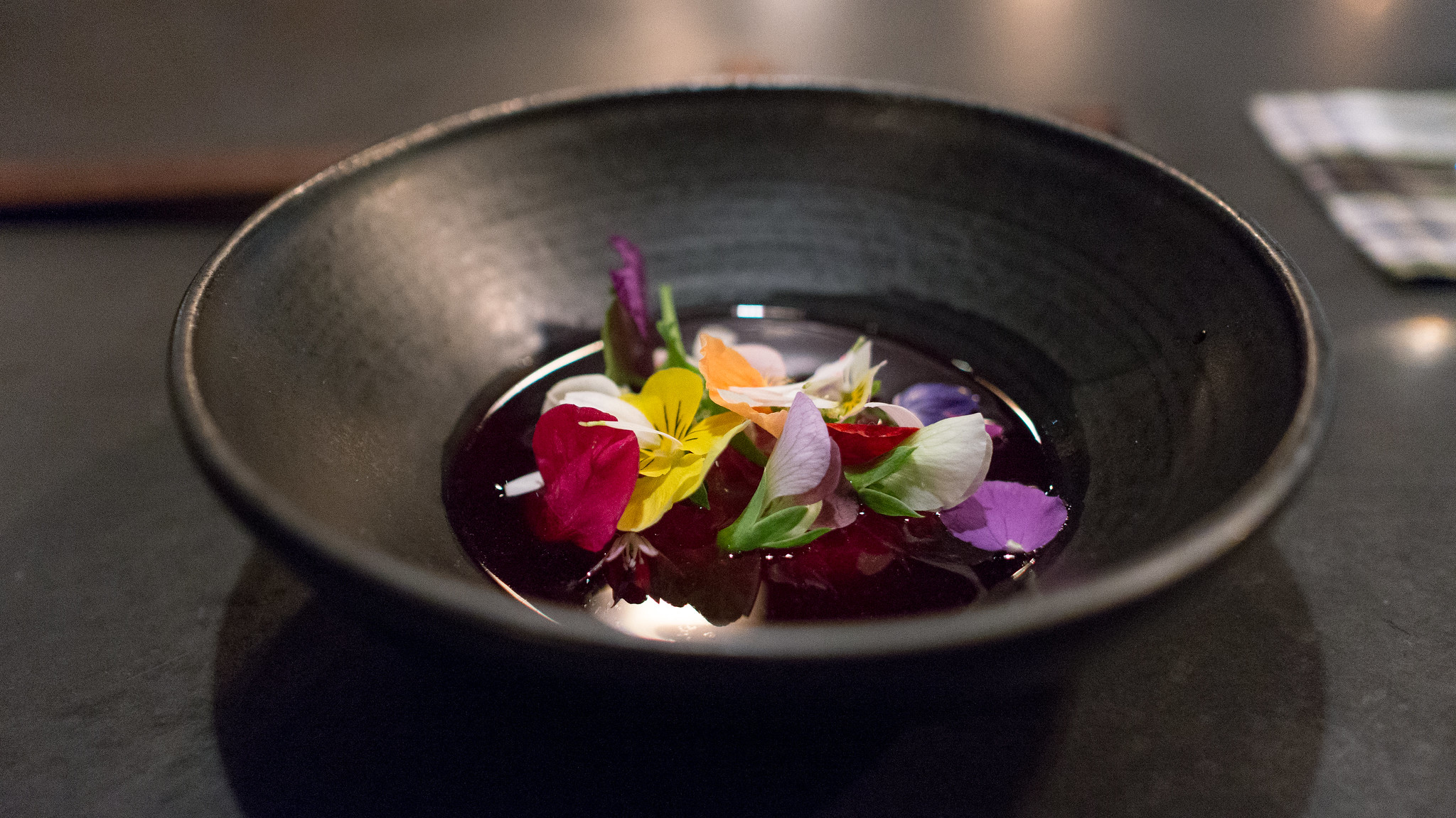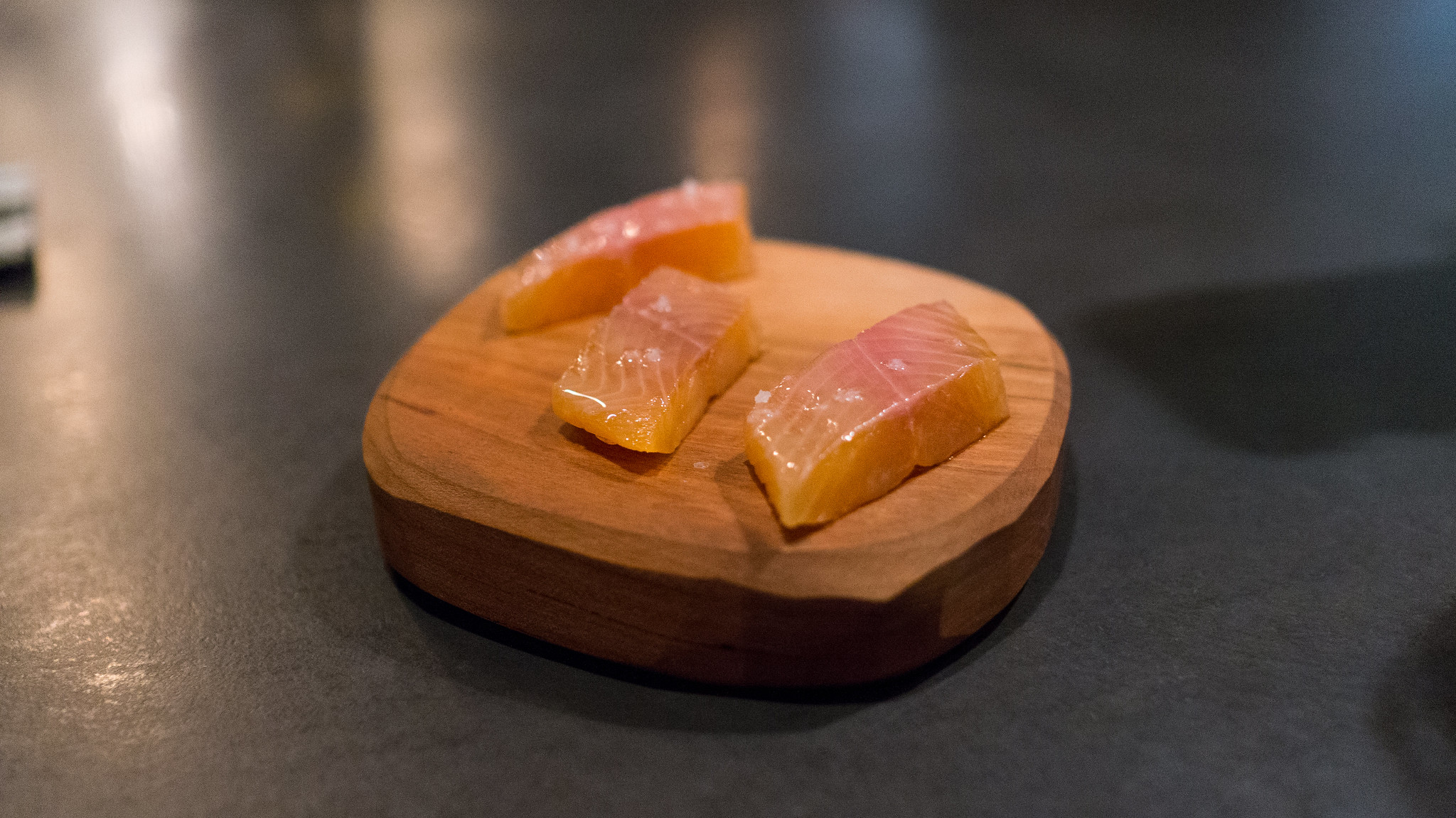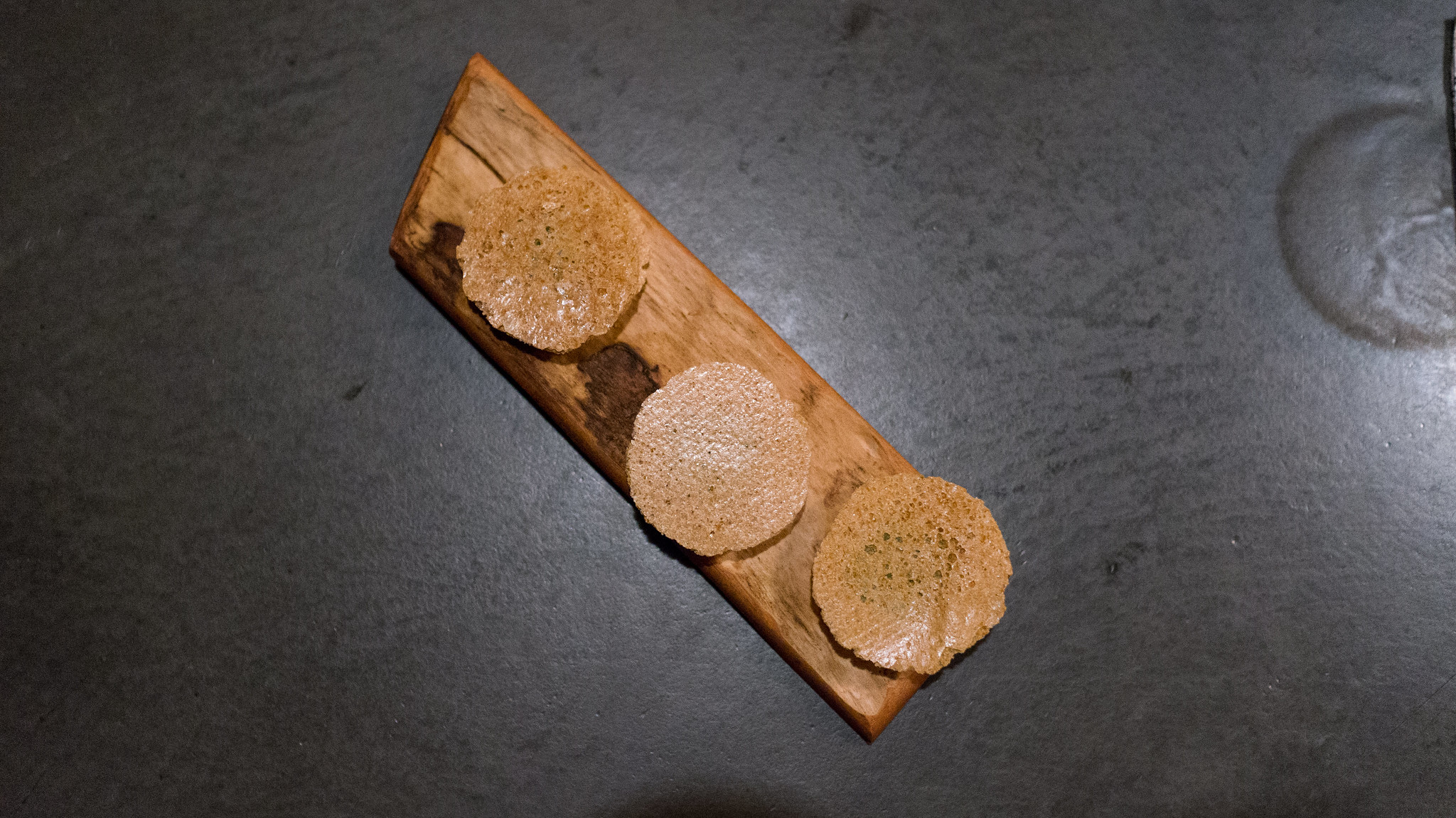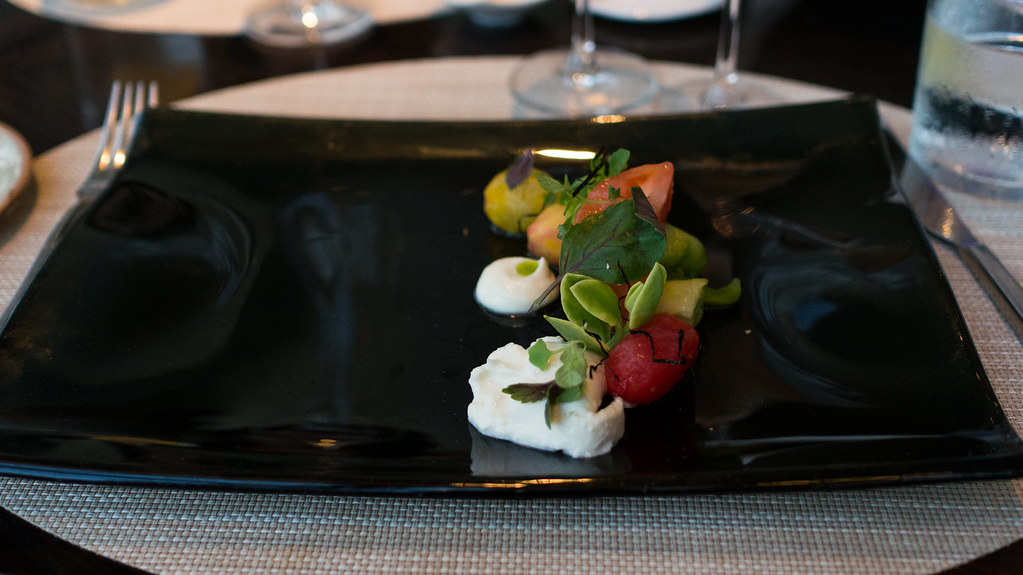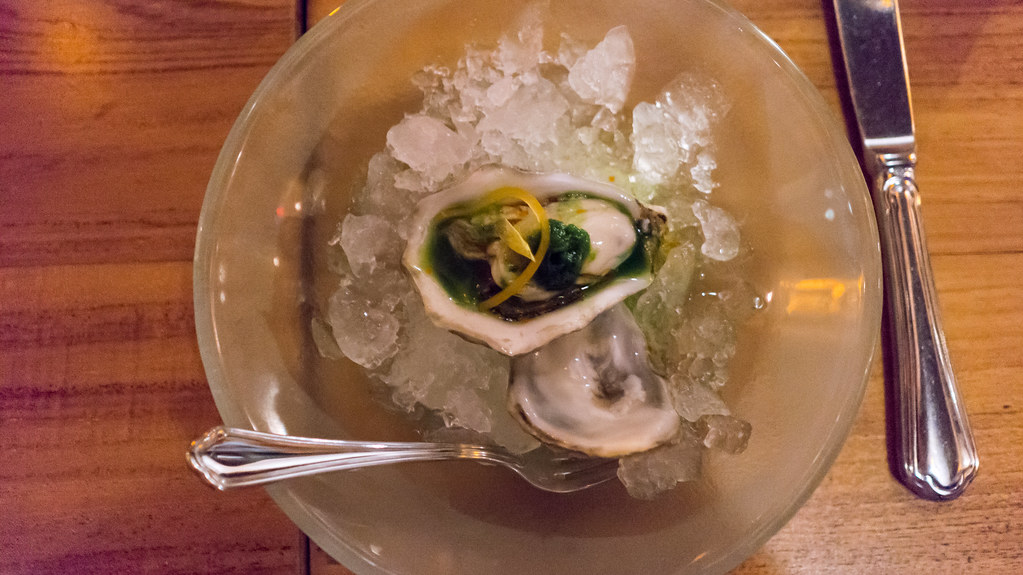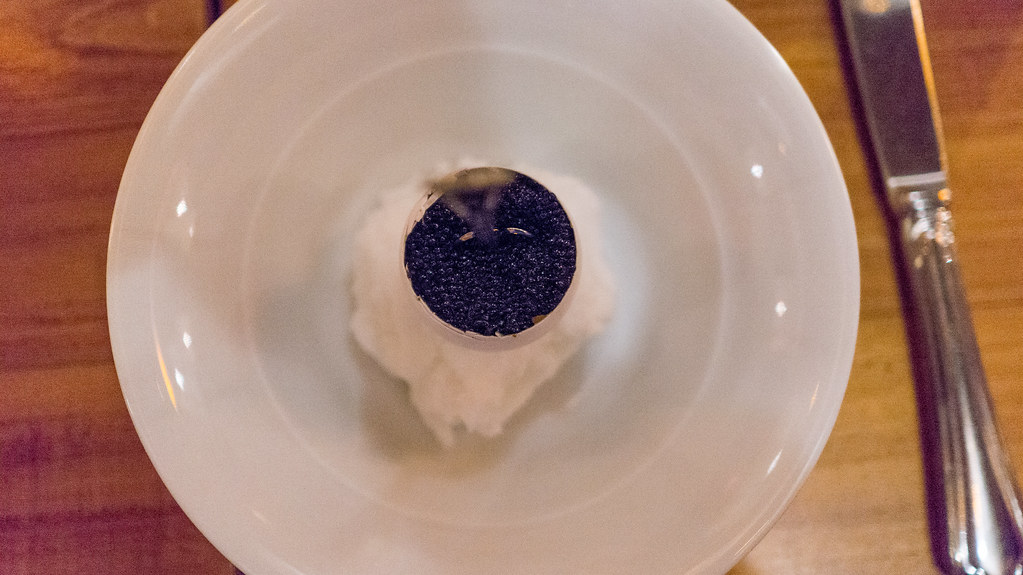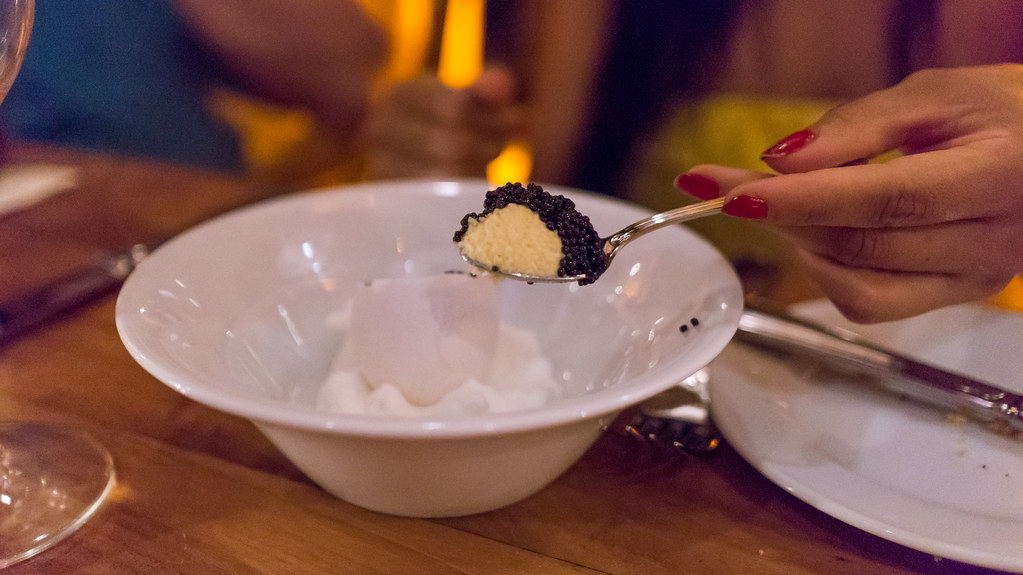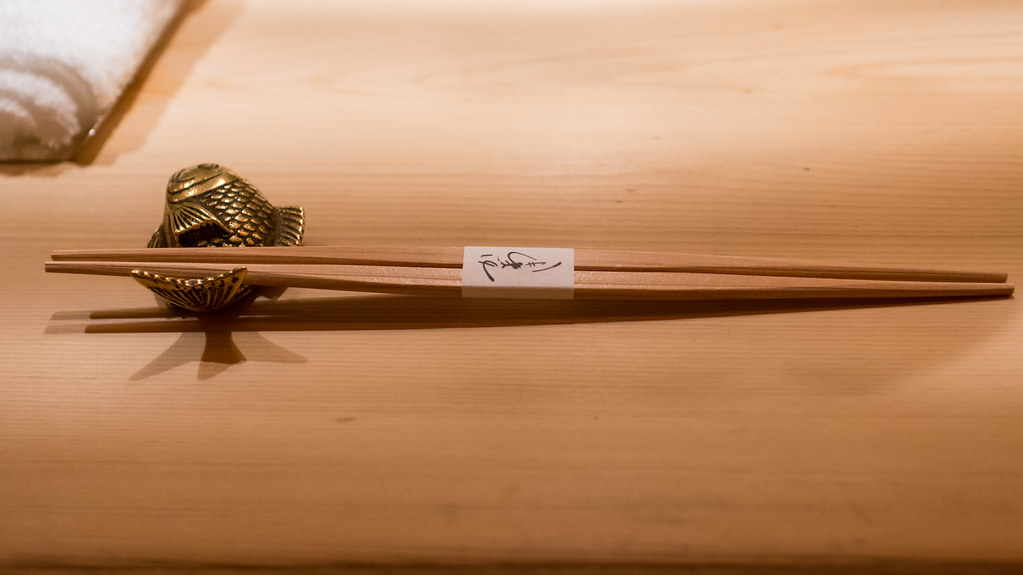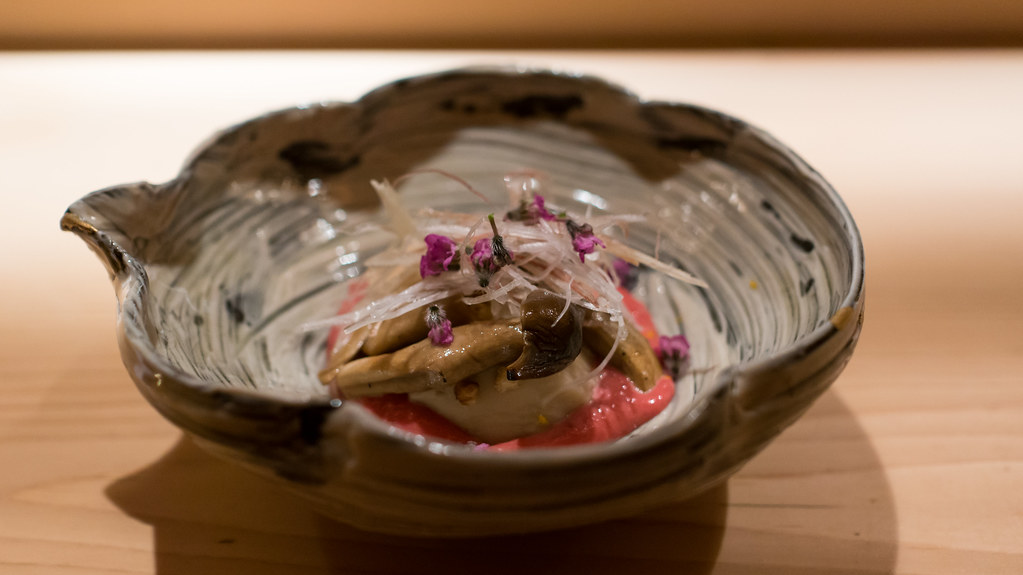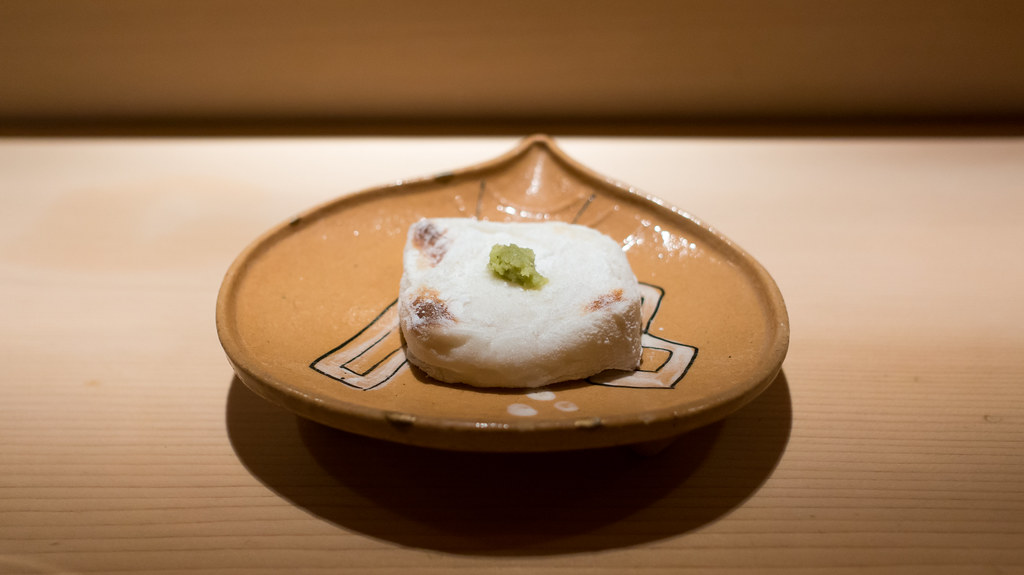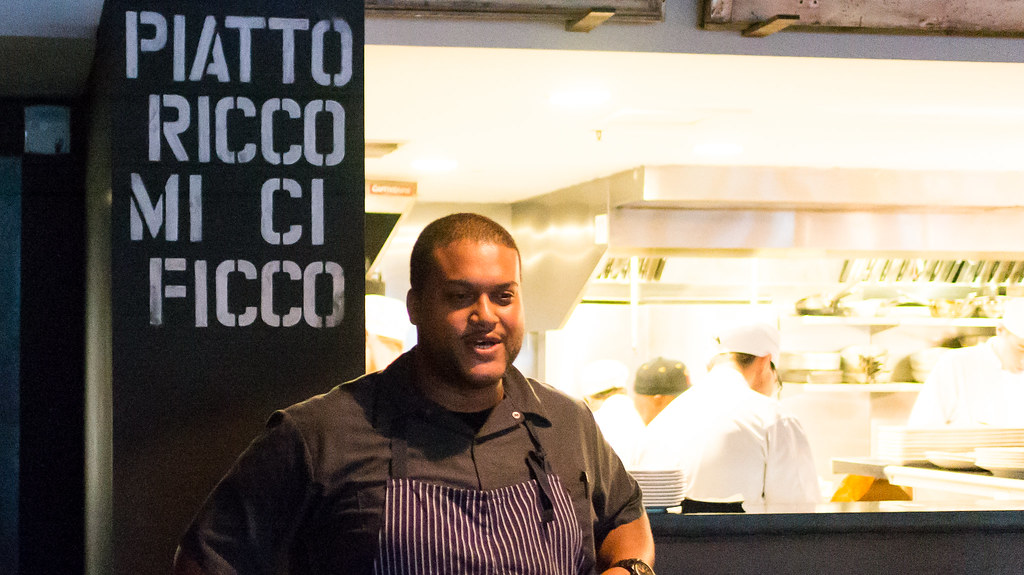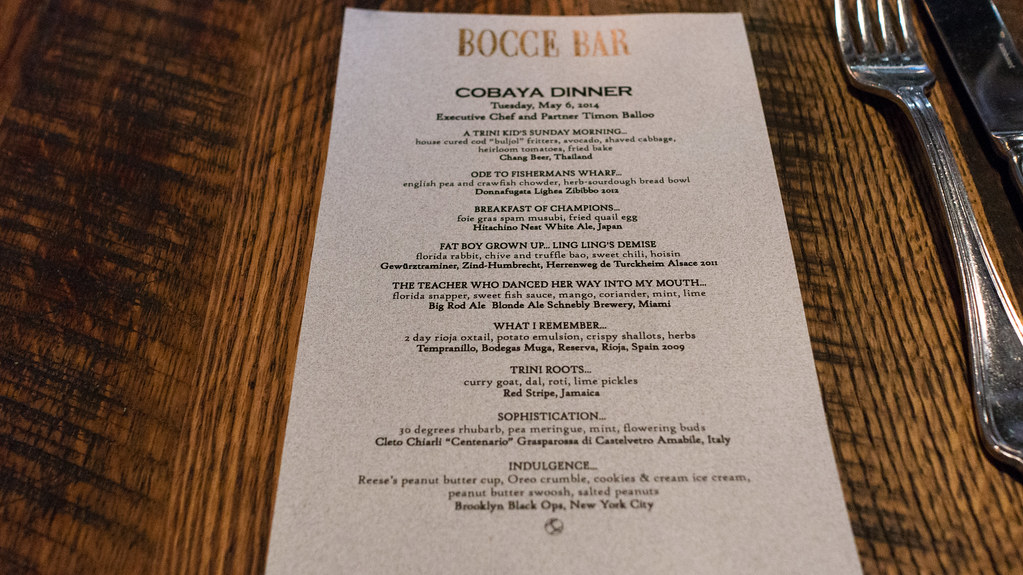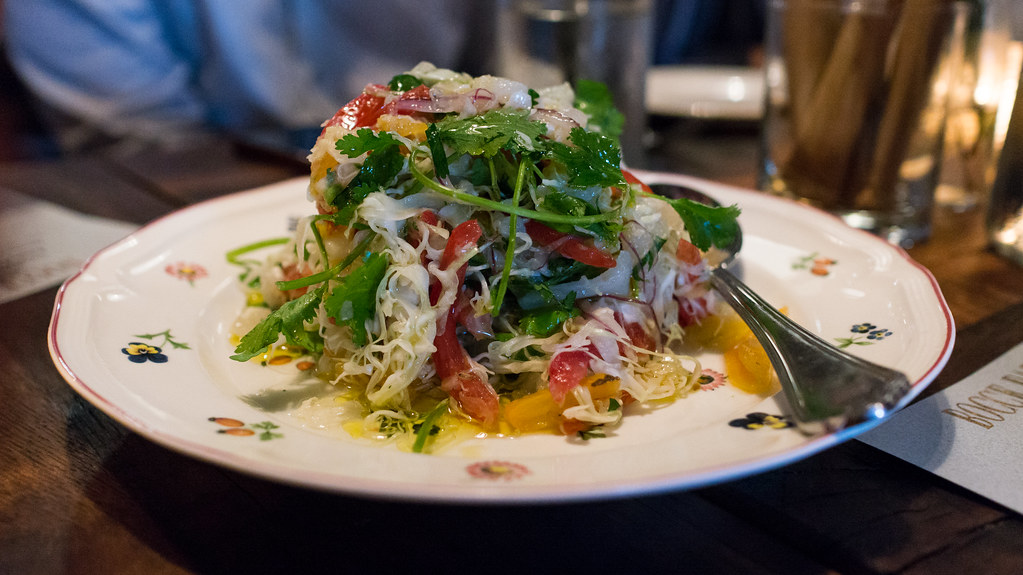I don't believe in "fate," but I'm a big fan of serendipity.
Last week, Frod Jr. had to get to Cornell University on Saturday morning, where he's taking courses this summer. It turns out this is not a simple task, as there are almost no flights into Ithaca. Things actually got a bit easier when I needed to be in New York City for work earlier in the week. Frod Jr. came up with me, and had a couple days free in the city before we rented a car and drove to Ithaca. That worked out perfectly.
Then Thursday night while we're up there, I get a text from Miami chef Jeremiah Bullfrog, who had just been at Bonnaroo breaking in his new gastroPod, a diner built in a shipping container: "You in NY??" he asks. Sure enough, he is too, and we've both got Friday night free for dinner. I scour OpenTable to see what's available, and – can this be for real? – there's a 9:30 reservation for three open at Atera. A place I've been wanting to go to since it opened, and for which Friday night tables are usually booked weeks ahead. Should we do it, Jeremiah? "Yes yes yes." And this, too, worked out perfectly.
The chef, Matthew Lightner, who had spent time at Noma and Mugaritz, was getting lots of attention for his "modernist" interpretation of Pacific Northwest cuisine at Castagna in Portland when he switched coasts to open Atera in 2012. It's easy to see how he was lured away: Atera is many a chef's dream come true. Hidden behind an unassuming entrance near Tribeca is a snug room with twelve seats around a matte black concrete counter facing into a gleaming open kitchen.[1] One twenty-ish course tasting menu is served to two seatings every night, and Lightner and crew seem to work with absolute freedom.
When Atera first opened a couple years ago, that freedom was reflected in provocative dishes like pig's blood crackers and lichen crisps. From my recent meal there, it seems those confrontational inclinations have been tempered. This is not "comfort food" by any means – the creative impulses that fuel the menu remain readily apparent – but I left feeling more coddled than challenged, in the best possible way.[2]
(You can see all my pictures in this atera flickr set; and though I don't usually toot my own horn, seriously, go look – I don't think I've ever been quite as happy with my own pictures).
A burst of color starts the meal. A tranche of vermilion and white king crab rests in a pool of cool, crimson rhubarb juice, infused with wild ginger and dotted with fresh cream, topped with a few fragrant rose geranium blossoms. The crab is both lush and lean, a balance echoed by the thick cream floating on the surface of the tangy rhubarb.
An even more colorful bouquet followed. For a while, everyone was throwing edible flowers onto their dishes in imitation of Noma's "forager cuisine." Too often, it was this generation's equivalent of the parsley sprig – a garnish, arguably edible, but having no real relationship to the dish other than to look pretty. Here, the flowers are the heart of the dish: a ruby-hued broth of rose hips and petals, poured tableside into a bowl with slices of black bass and a spray of various blossoms.[3] The broth was intensely floral, but the acidity of the rose hips (a common source of Vitamin C) tempered the suggestion that you were digging into a bowl of potpourri. A very light charcoal-grilled sear on the fish – so clean and fresh – helped keep it from getting lost.
Then, a sort of "nose to tail" triptych of trout. First, trout liver, packaged into a sort of sandwich with apple, toast and powdered brown butter. Next, slabs of the trout filet – cured, smoked, and brushed with pork fat, presented entirely unadorned – a perfect bite. Finally, smoked trout roe, with a clean brininess that pops in your mouth, sandwiched between crisp, lacy amaranth crackers, bound with a bit of tartar sauce.
(continued ...)
Sunday, June 29, 2014
Tuesday, June 24, 2014
J&G Grill - Bal Harbour
I usually don't write about restaurants based on off-the-menu experiences, particularly those of the "cook for me" variety.[1] But exceptionalism is cause for making exceptions. Chef de Cuisine Bradley Kilgore and Executive Pastry Chef Antonio Bachour are doing exceptional things right now at J&G Grill in Bal Harbour, and it seems foolish not to speak of them.
I've been talking Brad up for years, going back to our Cobaya dinner at Azul in 2011 where he was a sous chef at the time. After a brief stint heading the short-lived Exit 1 on Key Biscayne, Brad landed as chef de cuisine at Jean-Georges Vongerichten's J&G Grill in the St. Regis, where he's finally had the resources to match his talent and ambition. He also has had the benefit of teaming up with Antonio Bachour, whose pastry work is, and I don't exaggerate, brilliant.
To celebrate a recent birthday, the family let me choose where to go,[2] and I quickly opted for J&G. The truth is, while I've tasted Brad and Antonio's work on several occasions, most often it has been at special event type things.[3] I wanted to have a full-blown dinner there, and yes, I did kind of want to lay it on thick: it was a birthday after all. So I asked them to do a tasting menu for the family. And it was easily one of the best meals I've had in Miami this year.
To start, oysters "in their natural setting:" a freshly shucked oyster, swimming in a mignonette gelee, perched on a mound of squid ink and salt "sand," with various seaweeds strewn about and puffs of verjus foam washing up here and there. It's a gorgeous presentation of the clean, fresh flavors of the ocean – the only flaw is that the squid ink "sand" is too salty to really be edible (something our server warned us of).
(You can see all my pictures in this J&G Grill flickr set.)
A variation on a dish from the regular menu: oozy burrata cheese, paired with ginger glazed heirloom tomatoes, tiny herbs and greens, and a drizzle of shiso oil. The ginger and shiso are unexpected accompaniments, each with a razor's edge sharpness that cuts through the lusciously creamy cheese. J&G's sommelier, Luis Mejia, was particularly proud of his pairing for this course – the Leitz Dragonstone Riesling – and for good reason, as its balance of honeyed fruit, spice and acidity was an ideal match for the dish.[4]
The next course was a variation on a dish Brad had served me a couple years ago: slices of togarashi cured cobia, topped with bits of citrus, a puffy basil meringue, and delicate but assertively flavored watercress flowers. Dessert techniques – meringues, mousses, and sabayons, for instance – regularly weave their way into Brad's savory dishes to good effect.
(continued ...)
I've been talking Brad up for years, going back to our Cobaya dinner at Azul in 2011 where he was a sous chef at the time. After a brief stint heading the short-lived Exit 1 on Key Biscayne, Brad landed as chef de cuisine at Jean-Georges Vongerichten's J&G Grill in the St. Regis, where he's finally had the resources to match his talent and ambition. He also has had the benefit of teaming up with Antonio Bachour, whose pastry work is, and I don't exaggerate, brilliant.
To celebrate a recent birthday, the family let me choose where to go,[2] and I quickly opted for J&G. The truth is, while I've tasted Brad and Antonio's work on several occasions, most often it has been at special event type things.[3] I wanted to have a full-blown dinner there, and yes, I did kind of want to lay it on thick: it was a birthday after all. So I asked them to do a tasting menu for the family. And it was easily one of the best meals I've had in Miami this year.
To start, oysters "in their natural setting:" a freshly shucked oyster, swimming in a mignonette gelee, perched on a mound of squid ink and salt "sand," with various seaweeds strewn about and puffs of verjus foam washing up here and there. It's a gorgeous presentation of the clean, fresh flavors of the ocean – the only flaw is that the squid ink "sand" is too salty to really be edible (something our server warned us of).
(You can see all my pictures in this J&G Grill flickr set.)
A variation on a dish from the regular menu: oozy burrata cheese, paired with ginger glazed heirloom tomatoes, tiny herbs and greens, and a drizzle of shiso oil. The ginger and shiso are unexpected accompaniments, each with a razor's edge sharpness that cuts through the lusciously creamy cheese. J&G's sommelier, Luis Mejia, was particularly proud of his pairing for this course – the Leitz Dragonstone Riesling – and for good reason, as its balance of honeyed fruit, spice and acidity was an ideal match for the dish.[4]
The next course was a variation on a dish Brad had served me a couple years ago: slices of togarashi cured cobia, topped with bits of citrus, a puffy basil meringue, and delicate but assertively flavored watercress flowers. Dessert techniques – meringues, mousses, and sabayons, for instance – regularly weave their way into Brad's savory dishes to good effect.
(continued ...)
Tuesday, May 27, 2014
Cobaya Conor at The Dutch
Almost exactly two years ago we did a "Cobaya" dinner – Experiment #24 – at The Dutch. Number 24 was one of only two Cobaya dinners over the course of the past nearly five years that I couldn't attend. It was a tough one to miss – Chef Andrew Carmellini came down from New York and put on a show that many veteran guinea pigs say was among the best we've ever had.[1]
Since then, I've been to a number of great events at The Dutch: the Hurricane Sandy Relief Dinner we helped coordinate in late 2012, a really classy Spring Equinox Dinner that The Dutch's local chef de cuisine Conor Hanlon put on last year with chef Brad Kilgore (before Brad was hired at JG Grill), an indulgent "Trufflepalooza" a few months ago. But what I really wanted was another Cobaya, this one with Conor getting to do his thing. It came together this past week, and fortunately, I didn't miss this one.
We had a smaller group than usual – only 25 – at Conor's request, so that he could really focus and do more complex, individually plated items, rather than the family style service we've had at prior events. His menu spanned ten courses, each round dramatically delivered to the table simultaneously for all diners at once by a swat team of servers.
We started with a raw Stellar Bay oyster on crushed ice, garnished with a spicy, vegetal nasturtium granite, roasted tomato oil, celery, and Meyer lemon: a lot of flavors packed into one bite, designed to duplicate the flavors of a Bloody Mary.
Another spin on classic flavors: Conor's "Eggs on Eggs" packed a silky deviled egg farce into a cleaned eggshell, and then spackled the surface with a generously thick layer of black bowfin caviar. The briny saline pop of the roe was a nice contrast against the creamy, mildly spicy egg mousse.
I was floored, though, by the next course. A creamy, tangy buttermilk panna cotta served as the base for a composition that was like a spring cornucopia: stalks and spears of white and green asparagus, fresh shucked peas, golden-orange smoked trout roe, pickled mustard seeds, a tangle of delicate greens and flowers, all nestled into a bed of crispy dark brown quinoa. Every bite yielded a different combination of flavors, textures and colors. Just an outstanding dish.
(continued ...)
Since then, I've been to a number of great events at The Dutch: the Hurricane Sandy Relief Dinner we helped coordinate in late 2012, a really classy Spring Equinox Dinner that The Dutch's local chef de cuisine Conor Hanlon put on last year with chef Brad Kilgore (before Brad was hired at JG Grill), an indulgent "Trufflepalooza" a few months ago. But what I really wanted was another Cobaya, this one with Conor getting to do his thing. It came together this past week, and fortunately, I didn't miss this one.
We had a smaller group than usual – only 25 – at Conor's request, so that he could really focus and do more complex, individually plated items, rather than the family style service we've had at prior events. His menu spanned ten courses, each round dramatically delivered to the table simultaneously for all diners at once by a swat team of servers.
We started with a raw Stellar Bay oyster on crushed ice, garnished with a spicy, vegetal nasturtium granite, roasted tomato oil, celery, and Meyer lemon: a lot of flavors packed into one bite, designed to duplicate the flavors of a Bloody Mary.
Another spin on classic flavors: Conor's "Eggs on Eggs" packed a silky deviled egg farce into a cleaned eggshell, and then spackled the surface with a generously thick layer of black bowfin caviar. The briny saline pop of the roe was a nice contrast against the creamy, mildly spicy egg mousse.
I was floored, though, by the next course. A creamy, tangy buttermilk panna cotta served as the base for a composition that was like a spring cornucopia: stalks and spears of white and green asparagus, fresh shucked peas, golden-orange smoked trout roe, pickled mustard seeds, a tangle of delicate greens and flowers, all nestled into a bed of crispy dark brown quinoa. Every bite yielded a different combination of flavors, textures and colors. Just an outstanding dish.
(continued ...)
Wednesday, May 21, 2014
"west meets east" | Azabu Kadowaki - 麻布かどわき- Tokyo
Japan would seem to have a massive trade surplus when it comes to culinary inspiration. From the minimalist lightness of French nouvelle cuisine of the 1970's, to America's never-ending if not always quality-driven fixation on sushi, to "fusion" in so many guises, to this past decade's ramen craze, the traffic in ideas appears to be largely outbound. But Japan also absorbs influences too; and when it does so, it's usually with the same intense dedication to craft that pervades virtually all other pursuits there.[1]
Azabu Kadowaki is a resolutely Japanese restaurant; in fact, chef Toshiya Kadowaki was famed for turning down stars when the Michelin guide first came to Japan, on the basis that “Japanese food was created here, and only Japanese know it ... How can a bunch of foreigners show up and tell us what is good or bad?” (He ultimately relented, as the restaurant now has two of those stars that Kadowaki initially shunned.) But it also clearly bears the mark of some Western influences, filtered through a Japanese prism.
If I have my genres right, Kadowaki is a "kappo ryori" restaurant – high end food served straight from the kitchen, usually by the chef himself presenting it across the counter. It is an elegantly appointed space: honed wood counters and cabinets with the precision workmanship of a luxury yacht, cooking instruments all encased in patterned ceramic. There were maybe eight seats at the bar that faced that gorgeous open kitchen, though there appeared to be a couple private rooms as well that servers flitted in and out of.
(You can see all my pictures in this Azabu Kadowaki flickr set.)
The meal is omakase style: other than a diner's selection between snow crab and fugu as a "main" course, and between three different price points (all designated when the reservation is booked), everything else is chef's choice.
Our dinner started with an unusual and beautiful dish: a block of rich, nutty sesame tofu, nestled in a bed of magenta-hued beet miso, crowned with some meaty roasted mushrooms and bright purple flower buds. It defied any stereotype of a tofu-based dish being bland or insubstantial.
Almost simultaneously, we were also served a block of what I believe was either mochi or konnyaku (a/k/a yam cake or devil's tongue jelly). Toasted around the edges, it was chewy, almost elastic in texture, and blandly starchy in flavor other than the dab of freshly grated wasabi. It was texturally intriguing, but I can't say much more about it than that.
The next course was one of my favorites, blending eastern and western components: a cube of winter daikon radish draped with a slice of roasted pear, all enrobed in a creamy cod roe sauce and topped with a fine julienne of fresh black truffle. Cooked daikon is a highly underrated ingredient: tender but still having substance, silky but with a pleasing bite of graininess against the teeth, and a mild sweet flavor. Those qualities were mirrored and amplified by the roasted pear, which brought a more intense caramelized sweetness, the mildly salty, creamy sauce, and the earthy, aromatic truffle. There were no bold flavors here – rather it was all subtlety and grace.
(continued ...)
Azabu Kadowaki is a resolutely Japanese restaurant; in fact, chef Toshiya Kadowaki was famed for turning down stars when the Michelin guide first came to Japan, on the basis that “Japanese food was created here, and only Japanese know it ... How can a bunch of foreigners show up and tell us what is good or bad?” (He ultimately relented, as the restaurant now has two of those stars that Kadowaki initially shunned.) But it also clearly bears the mark of some Western influences, filtered through a Japanese prism.
If I have my genres right, Kadowaki is a "kappo ryori" restaurant – high end food served straight from the kitchen, usually by the chef himself presenting it across the counter. It is an elegantly appointed space: honed wood counters and cabinets with the precision workmanship of a luxury yacht, cooking instruments all encased in patterned ceramic. There were maybe eight seats at the bar that faced that gorgeous open kitchen, though there appeared to be a couple private rooms as well that servers flitted in and out of.
(You can see all my pictures in this Azabu Kadowaki flickr set.)
The meal is omakase style: other than a diner's selection between snow crab and fugu as a "main" course, and between three different price points (all designated when the reservation is booked), everything else is chef's choice.
Our dinner started with an unusual and beautiful dish: a block of rich, nutty sesame tofu, nestled in a bed of magenta-hued beet miso, crowned with some meaty roasted mushrooms and bright purple flower buds. It defied any stereotype of a tofu-based dish being bland or insubstantial.
Almost simultaneously, we were also served a block of what I believe was either mochi or konnyaku (a/k/a yam cake or devil's tongue jelly). Toasted around the edges, it was chewy, almost elastic in texture, and blandly starchy in flavor other than the dab of freshly grated wasabi. It was texturally intriguing, but I can't say much more about it than that.
The next course was one of my favorites, blending eastern and western components: a cube of winter daikon radish draped with a slice of roasted pear, all enrobed in a creamy cod roe sauce and topped with a fine julienne of fresh black truffle. Cooked daikon is a highly underrated ingredient: tender but still having substance, silky but with a pleasing bite of graininess against the teeth, and a mild sweet flavor. Those qualities were mirrored and amplified by the roasted pear, which brought a more intense caramelized sweetness, the mildly salty, creamy sauce, and the earthy, aromatic truffle. There were no bold flavors here – rather it was all subtlety and grace.
(continued ...)
Monday, May 19, 2014
CobayaBalloo - Chef Timon Balloo at Bocce Bar
I love a meal that tells a good story. A meal can be a journey – like Norman Van Aken's menus, traversing the flavors of the Caribbean, Asia, Latin America and Iberia. Some of the best are those that aspire to simply reflect a time and place – the flavor of the here and now, as Blaine Wetzel does to such great success at Willows Inn. Still others are more personal, attempting to recapture a particular taste memory or flavor sensation – that tunnel-vision view into a childhood experience so magnificently captured in the film Ratatouille.
This last type is often the most difficult to pull off, because there is no guarantee everyone has the same memory bank of experiences, or that they were absorbed in the same way. (For more thoughts on "story food" and capturing food memories, read this recent piece by Bruce Palling in "Cutting Edge Chefs Serve Up Food That Tells a Story"). Getting the backstory is helpful, which is part of why interaction can be a key to a meaningful dining experience.
Chef Timon Balloo took the autobiographical approach to the Cobaya dinner he put on last week, putting together a menu that told the story of his life in food. He also did a great job filling in the backstory which wound a meandering path from a Trinidadian childhood breakfast to the two Midtown Miami restaurants – Sugarcane Raw Bar Grill and Bocce Bar – that he runs today.
(You can see all my pictures in this CobayaBalloo flickr set).
Our group of nearly forty guinea pigs took over several large tables set in front of the open kitchen of Bocce Bar, which recently opened a few doors down from Sugarcane in the space which was formerly occupied by Sustain. As we always do, we told Timon that we didn't want "Sugarcane" food or "Bocce Bar" food – we wanted "Timon" food. He did exactly that, with a nine-course menu that paid tribute to his culinary influences and inspirations.
Growing up in a Trinidadian family, this was a typical weekend breakfast – salt cod tossed with shredded cabbage, tomatoes and fresh herbs, tucked into "bake," a simple, dense, chewy bread (you may have also heard of "Bake and Shark," another typical Trini recipe). This doesn't look or sound like much, but it was one of the dishes of the night for me, and a great start to our meal.[1] The snappy, spicy Chang Beer pairing was also right on target, as were all the pairings, which smartly and effectively featured beers as often as wines.
Chef Balloo spent some formative years in San Francisco, and while there are several potential candidates for an iconic San Francisco dish, the chowder in a sourdough bread bowl served at dozens of spots along Fisherman's Wharf may be the most ubiquitous. Timon stuck with the classic format but put a seasonal spin on the ingredients, subbing in a crawfish bisque studded with English peas for the typical clam and potato chowder.
(continued ...)
This last type is often the most difficult to pull off, because there is no guarantee everyone has the same memory bank of experiences, or that they were absorbed in the same way. (For more thoughts on "story food" and capturing food memories, read this recent piece by Bruce Palling in "Cutting Edge Chefs Serve Up Food That Tells a Story"). Getting the backstory is helpful, which is part of why interaction can be a key to a meaningful dining experience.
Chef Timon Balloo took the autobiographical approach to the Cobaya dinner he put on last week, putting together a menu that told the story of his life in food. He also did a great job filling in the backstory which wound a meandering path from a Trinidadian childhood breakfast to the two Midtown Miami restaurants – Sugarcane Raw Bar Grill and Bocce Bar – that he runs today.
(You can see all my pictures in this CobayaBalloo flickr set).
Our group of nearly forty guinea pigs took over several large tables set in front of the open kitchen of Bocce Bar, which recently opened a few doors down from Sugarcane in the space which was formerly occupied by Sustain. As we always do, we told Timon that we didn't want "Sugarcane" food or "Bocce Bar" food – we wanted "Timon" food. He did exactly that, with a nine-course menu that paid tribute to his culinary influences and inspirations.
"A Trini Kid's Sunday Morning"
house cured cod "buljol" fritters, avocado, shaved cabbage, heirloom tomatoes, fried bake
Chang Beer, Thailand
Growing up in a Trinidadian family, this was a typical weekend breakfast – salt cod tossed with shredded cabbage, tomatoes and fresh herbs, tucked into "bake," a simple, dense, chewy bread (you may have also heard of "Bake and Shark," another typical Trini recipe). This doesn't look or sound like much, but it was one of the dishes of the night for me, and a great start to our meal.[1] The snappy, spicy Chang Beer pairing was also right on target, as were all the pairings, which smartly and effectively featured beers as often as wines.
"Ode to Fisherman's Wharf"
english pea and crawfish chowder, herb-sourdough bread bowl
Donnafugata Lighea Zibibbo 2012
Chef Balloo spent some formative years in San Francisco, and while there are several potential candidates for an iconic San Francisco dish, the chowder in a sourdough bread bowl served at dozens of spots along Fisherman's Wharf may be the most ubiquitous. Timon stuck with the classic format but put a seasonal spin on the ingredients, subbing in a crawfish bisque studded with English peas for the typical clam and potato chowder.
(continued ...)
Subscribe to:
Posts (Atom)

